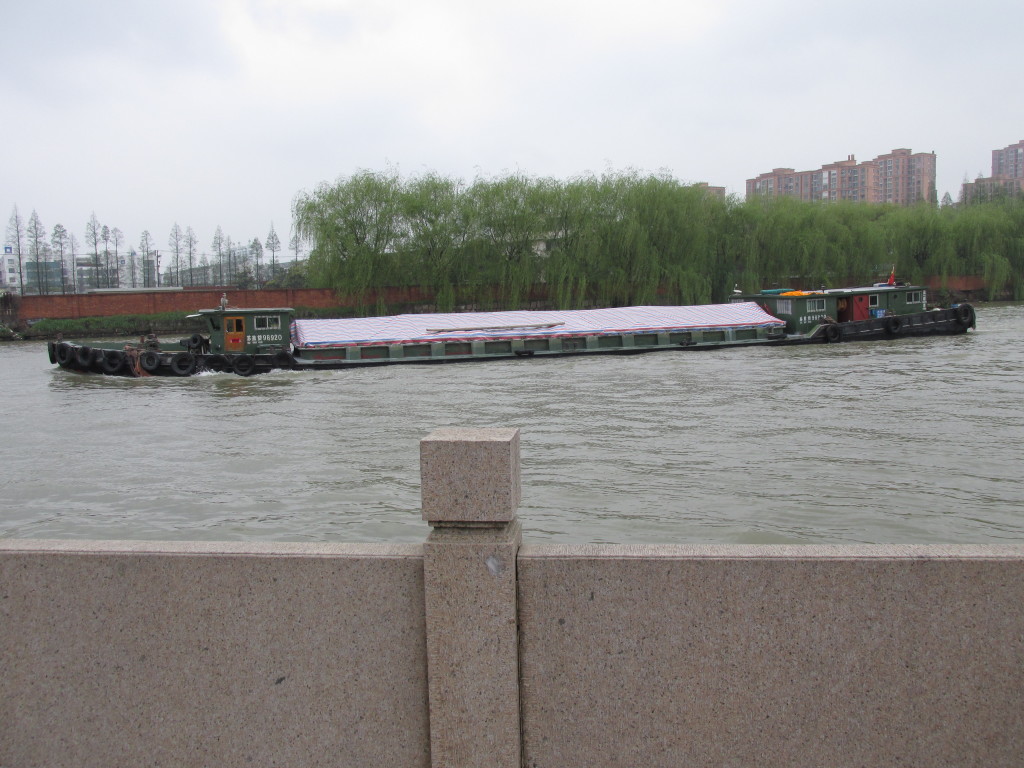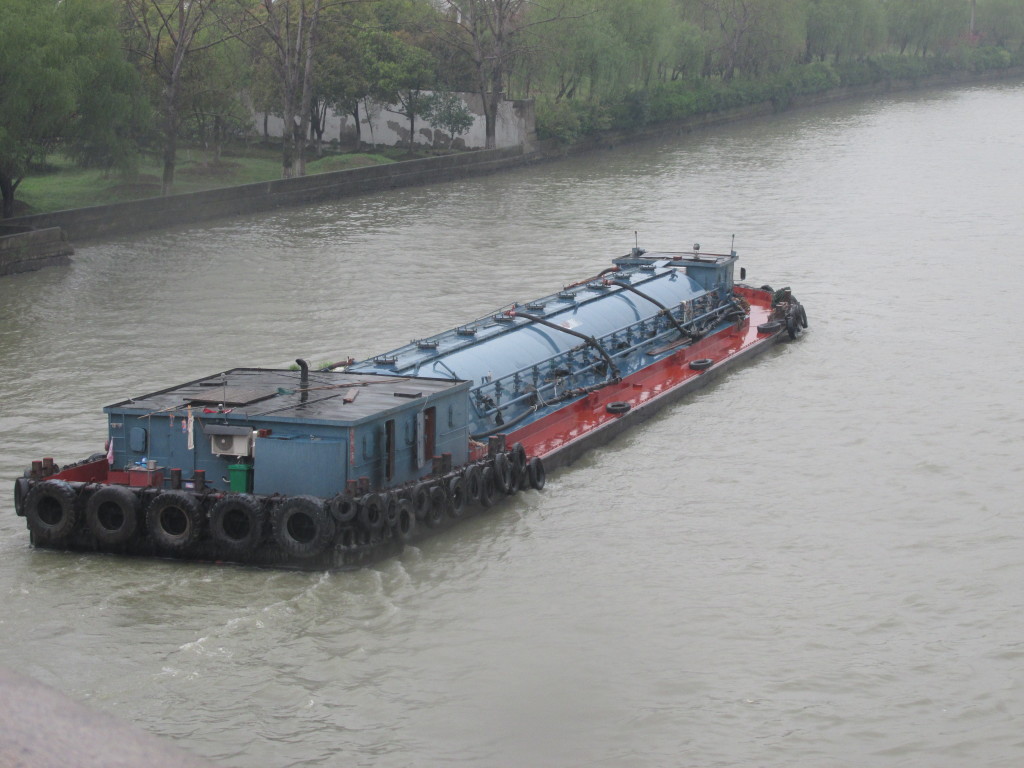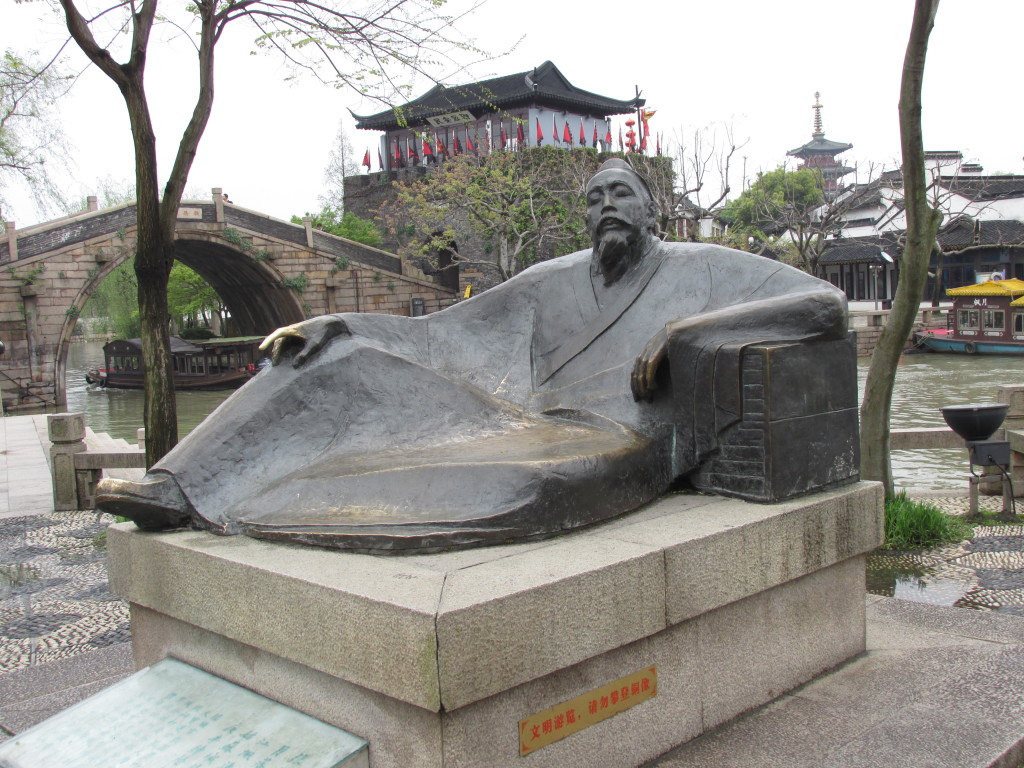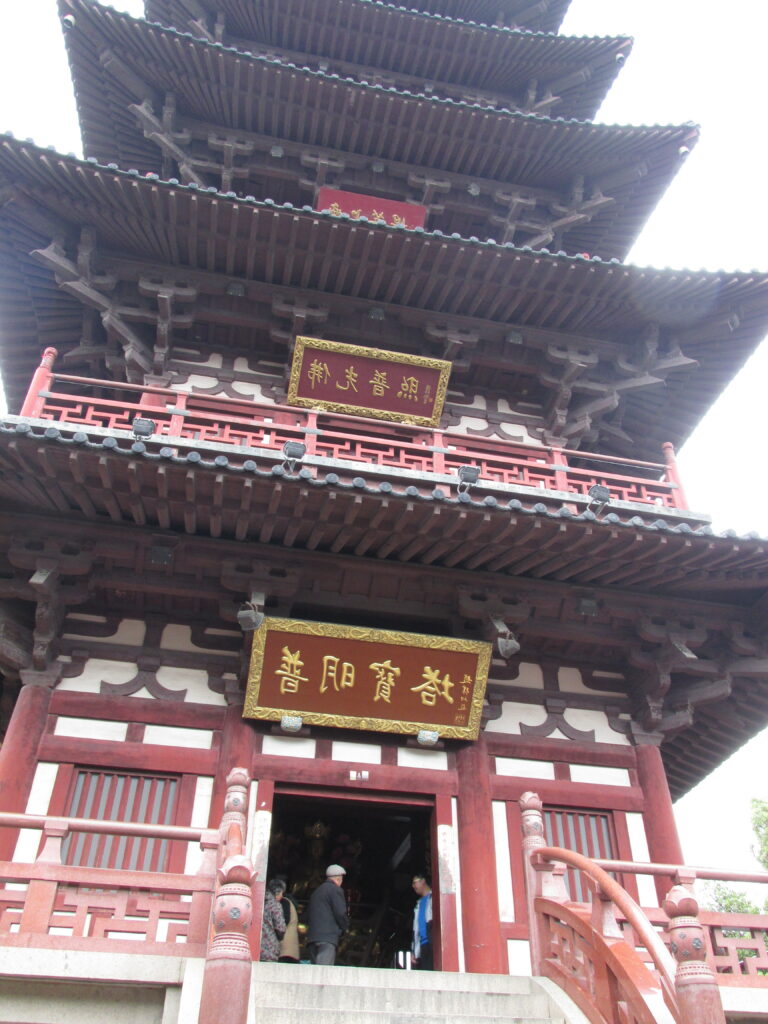The Grand Canal
The Grand Canal, begun in the 5th century B.C. and finally completed over a thousand years later, ranks as the second-greatest public works project of ancient China. In most other countries it would easily rank #1. As we contemplate its 1,776 kilometres stretching from Beijing in the north to Hangzhou in the south, we are amazed, first, that it was ever built, and second, that it still exists. Luckily for those of us who live in Suzhou, the Canal passes along the western edge of the city and is easily accessible. In the same place you can visit the Feng Qiao (“Maple Bridge”) area and the Hanshan Temple in anywhere from 2-3 hours to a whole day, depending on your lingering powers.
I always go by taxi, at least for the last bit of the journey; the nearest bus stop is not very near! To save on cab fare, take the #1 subway line to Xi Huan Lu and catch a taxi from there going north. You will be dropped at the entrance to the whole area, where a new gate has been erected and the street running along the southern edge of the temple grounds is now restricted (mostly) to pedestrians. Walk through the gateway, westward, with the temple on your right (you will recognize the ubiquitous yellow colour of the walls) and a collection of new structures for tourists on your left. Keep an eye out for the exit from the temple grounds, on your right; this is where you will emerge when you leave the temple. Walk all the way to the end, turn right (north), and you will see a small stone bridge (Jiancun Qiao). Cross it—taking time to admire the view from on top—and then proceed to buy your admission ticket to the Feng Qiao area. Once through the turnstiles, linger as you like at the touristy shops (all new in the past decade) and then continue heading due west towards the Grand Canal. You will know it when you see it.
I have read that in other sections the Canal has been prettied up for tourists, and no doubt that ambiguously happy future awaits the Suzhou section, but for the moment at least the Grand Canal remains solidly working-class. When I first saw it in 2004 its width was filled with two lines of barges, tail to toe, one heading north and the other south. The loads, when identifiable, included a good deal of sand and gravel. The loaded barges, deep in the water, had their gunnels lapped by the waves made by the other barges; the empty ones rode high, with perhaps four meters of keel showing. In more recent visits the traffic has been much diminished, but if you are lucky you will see at least some barges while you are there and have a glimpse of this vanishing way of life.
Walk north along the canal, as far as you can go. The little island you are on ends like the prow of a ship sailing north on the canal. I like to stand at the very tip and gaze northward, looking for Beijing. The little boy in me, the one who read stories of other little boys who joined the circus or ran off to sea, would love to jump onto one of those barges and head north. At the right is a wonderfully unattractive depot filled with piles of sand and gravel and other construction- and shipping-related materials, offering relief from the sanitized boutiques of the tourist areas. If you enjoy this spot as much as I do, I have another suggestion: the next time you go to Paris, cross the Pont Neuf and walk out to the west end of the Ile de la Cité: you will find yourself on the prow of another ship, this time sailing down the Seine through the middle of the City of Lights.
When you have had enough of the Grand Canal, make your way back as you came, but this time bear left (eastward), through the pavilions in another area created for tourists. On the left you will find a replica grain shop, where you can see old baskets and threshers and tools. Just beyond the grain shop, on the right, is a calligrapher’s workshop. You can see him at work, perhaps, and if you have a Chinese speaker with you, you can engage him in conversation. Even without any knowledge of calligraphy you will recognize that this fellow is a real artist in stone, metal, and of course on paper. Perhaps, if you are feeling prosperous, you will even be tempted to make a purchase. Further on, also on the right, and just before the street opens up into a little plaza, is a paper-cut shop. The old fellow there is very garrulous, in several languages. He still does some work himself, but most of it is done by his son. There is a huge range of quality and price here, with something for everyone and for every pocketbook. The kitschy pieces (do not miss the ‘Last Supper’!) excel in their own way, while the more serious (and expensive) work will stun you. There is a second floor (stairs at the back of the shop) that is worth the climb.
When you exit the paper-cut shop you will see the steps of Feng Qiao, the bridge that gives this area its name. Before you cross it, however, turn right to have a look at the wonderful statue of Zhang Ji (ca. 712-779), the Tang Dynasty poet whose only known poem was written right here. The poem, “Night Mooring at Maple Bridge” (枫桥夜泊) was enough to make him and Feng Qiao famous all over China. His more-than-life-sized statue shows him reclining rather imperiously; the poem itself can be seen on the wall to the left, as you are looking at the statue. Here is an English translation:
Moon falls, crows caw, frost fills the sky;
Under Maple Bridge, fishermen’s flares confront my weary eyes.
Outside the city wall lies Han Shan Temple;
Late at night the sound of its bell reaches a traveler’s boat.
Retrace your steps and cross the Feng Qiao, which is topped by a guard tower that dates from the Ming Dynasty, when this was one of the main outer defenses of Suzhou. You can climb the narrow stairway and get some nice views. If you are lucky the room at the top will be unlocked; if not you can look through the windows to see the old weapons on display.
As you continue on from the guard tower you pass through some turnstiles and return to the free area of the grounds. Be careful—there are two possible ways forward here, one to the left, the other to the right. Take the narrow one to the right. It will lead through a few metres of tourist shops. When you emerge at the other end you will see straight ahead the small bridge you crossed when you first arrived, and on your left the entrance to the Hanshan Temple. Buy your admission ticket on the right, opposite the entrance, and then head on in.
Hanshan Temple
Hanshan Temple is very old, but most of the original structures are long gone, with the oldest remaining buildings dating from the Qing Dynasty and the newest ones from last week. Every time I go there some other part of the complex is being refurbished. For Buddhist eye candy in Suzhou, therefore, this is the place. The temple is almost always crowded with tourists, partly because of Zhang Ji’s poem and partly because the site has become a center of Chinese-Japanese reconciliation since the Second World War.
If you are hungry, turn left just after passing through the front gate and you will find a small restaurant serving vegetarian fare. A bowl of vegetarian noodles will fill you up at little cost to your pocketbook. After that, just wander and enjoy. To really appreciate Hanshan you will need a Chinese speaker who knows about Buddhist culture, teachings, and history, but even without that there is a lot to see and enjoy. If you have children with you, or if you are still in touch with your inner child, you will not miss the opportunity to ring the bell that is in a small tower just to the right of the first big pavilion you see upon entering. If you don’t see it, you will hear it. (Buy your ticket off to the right, then stand in line; you get three kicks at the can, so to speak.)
Further on you will find a series of halls and shops. The big tower, like all towers around the world, offers you the chance to walk up far too many steps to admire the view from the top and, if you like, toss some coins onto the roof of the adjacent pavilion. There are many, many beautiful scenes to see, so photo opportunities abound. The Buddhist music playing and the incense-filled air add to your sensory overload. When you finish your visit, the exit is at the back (or east end) of the complex, through the south wall. It is not all the way at the back, so if you have gone all the way to the eastern limits you will have to return and find the exit. Once out you will be on the walking street where you entered, with the new gate on your left this time. If you are interested, there is a gigantic new bell tower across the street, in the middle of a very large plaza. It is here, I gather, where people now congregate on the lunar new year’s eve to hear the ringing of the bell. Not being a fan of standing out in the cold with hundreds or thousands of other people waiting for a bell to ring, I have yet to visit Hanshan on New Year’s Eve; if you go, let me know how you like it.
How to Get There
Hanshan Temple
寒山寺, Han2 shan1 si4
Take Line 1 on the subway to Xihuan Lu, and then flag a taxi going north on Xihuan Lu. To catch a taxi home, stand at the bend in the road where you were dropped off. Lots of taxis come by here, and either direction (south or east) will work.






